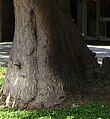Yucca gigantea
| Giant yucca | |
|---|---|

| |
| Scientific classification | |
| Kingdom: | Plantae |
| Clade: | Tracheophytes |
| Clade: | Angiosperms |
| Clade: | Monocots |
| Order: | Asparagales |
| Family: | Asparagaceae |
| Subfamily: | Agavoideae |
| Genus: | Yucca |
| Species: | Y. gigantea
|
| Binomial name | |
| Yucca gigantea | |
| Synonyms[1][2] | |
| |
Yucca gigantea (syn. Yucca elephantipes, Yucca guatemalensis),[1] is a Yucca species that is native to Belize, Costa Rica, El Salvador, Guatemala, Honduras, Nicaragua and the eastern part of Mexico (Quintana Roo, Yucatán, Campeche, Tabasco, Chiapas, Veracruz, eastern Puebla and southern Tamaulipas).[3] It is also reportedly naturalized in Puerto Rico, the Leeward Islands and Ecuador.[4]
Common names include spineless yucca, soft-tip yucca, blue-stem yucca, giant yucca and itabo. Its flower, the izote, is the national flower of El Salvador.
Description
Although it can grow up to 9 m (30 ft) in height, with a spread to 4.5 m (15 ft), it is usually less than 6 m (20 ft) in height. It may have a thick, single trunk or be multitrunked resulting from a thickened, inflated, trunk-like lower base similar to an elephant's foot.[5][6] The leaves are strap-like, spineless and up to 1.2 m (4 ft) in length. White flowers are produced in the summer, followed by brown, fleshy fruits which are oval and up to 2.5 cm (1 in) long.[5]
Taxonomy
The species is most widely known today as Yucca elephantipes. The first mention of that name was by Eduard von Regel in February 1859. He claimed that a different species, Y. aloifolia, was sometimes known as "Yucca elephantipes" when grown in European gardens because of its thickened stem base.[7] However, since he did not intend to offer Y. elephantipes as the actual correct name, this was not a valid publication. In a major article on yuccas and allies in 1902, William Trelease also used the name Y. elephantipes, referring to Regel's 1859 publication.[8] This came too late though, as Yucca gigantea had by then already been previously established.[9][10]
Charles Lemaire published the name Yucca gigantea in November 1859.[9] This is the name used by the World Checklist of Selected Plant Families as of January 2014[update],[1] although other sources use Yucca guatemalensis, published by Baker in 1872.[3]
Cultivation
The species can be grown in a variety of soils and is drought-tolerant. Young plants are occasionally used as houseplants. However the species grows best in a hot semi-arid climate, so plants are subject to root rot if overwatered. Older plants are generally the most susceptible. For this reason young, shorter trees are superior houseplants as they're more adaptable to environmental changes. Yucca gigantea can be affected by a number of pests including scale, Yucca moth borers, and yucca weevils.[11][12]. Leaf spot may affect the appearance of the leaves, but it does not affect the health of the plant. Propagation is by suckers, cuttings or seed.[5]
Cultivars
A number of cultivars have been released including:
- 'Artola Gold' [13]
- 'Jewel' [13]
- 'Puck' [14]
- 'Silver Star', a variegated form [13]
Uses
The flowers are used as ingredients in recipes due to their bitter taste. The plants are often used on coffee estates to prevent soil erosion on steep slopes.
Gallery
-
Yucca gigantea in the Parc de la Ciutadella, Barcelona
-
Izote, the national flower of El Salvador
-
Detail of the trunk base, similar to an elephant foot (hence the synonym elephantipes)
-
Young Yucca gigantea and Aloe vera kept as a houseplant
References
- ^ a b c d World Checklist of Selected Plant Families, 291761.
- ^ Tropicos, Yucca gigantea
- ^ a b "Yucca guatemalensis". Germplasm Resources Information Network. Agricultural Research Service, United States Department of Agriculture. Retrieved 2008-02-06.
- ^ Kew World Checklist of Selected Plant Families
- ^ a b c Edward F. Gilman and Dennis G. Watson. "Yucca elephantipes" (PDF). Environmental Horticulture, Florida Cooperative Extension Service, Institute of Food and Agricultural Sciences, University of Florida. Retrieved 19 February 2014.
- ^ Eggli, Urs (2001). Illustrated handbook of succulent plants. Springer. p. 93. ISBN 978-3-540-41692-0. Retrieved 26 February 2012.
- ^ von Regel, Eduard August (1859). "Aufzählung der Yucca-arten des Kaiserlichen Botanischen Gartens in St. Petersburg nebst Beiträgen zu deren Cultur". Gartenflora. 8: 34–38. Retrieved 2012-02-26. p. 35: "Wegen des am Grunde verdickten Stammes in den Gärten auch als Y. elephantipes gehend." (Going also in gardens as Y. elephantipes because of the thickened base of the stem).
- ^ Trelease, William (1902). "The Yucceae". Annual Report of the Missouri Botanical Garden. 13: 27–129. p. 94
- ^ a b Lemaire, Charles (1859). L'Illustration horticole, volume 6. J. Linder. p. 91.
- ^ Tropicos.org. "**Yucca elephantipes Regel". Missouri Botanical Garden. Retrieved 2012-02-26.
- ^ "Yucca weevil—Scyphophorus yuccae". Agriculture and Natural Resources, University of California. Retrieved 14 July 2016.
- ^ Ryczkowski, Angela. "Insects & Pests of the Yucca". San Francisco Gate. Retrieved 14 July 2016.
- ^ a b c "Yuccas". ABC. Retrieved 2008-02-06.
- ^ "Yucca". Royal Horticultural Society. Retrieved 2008-02-06.




